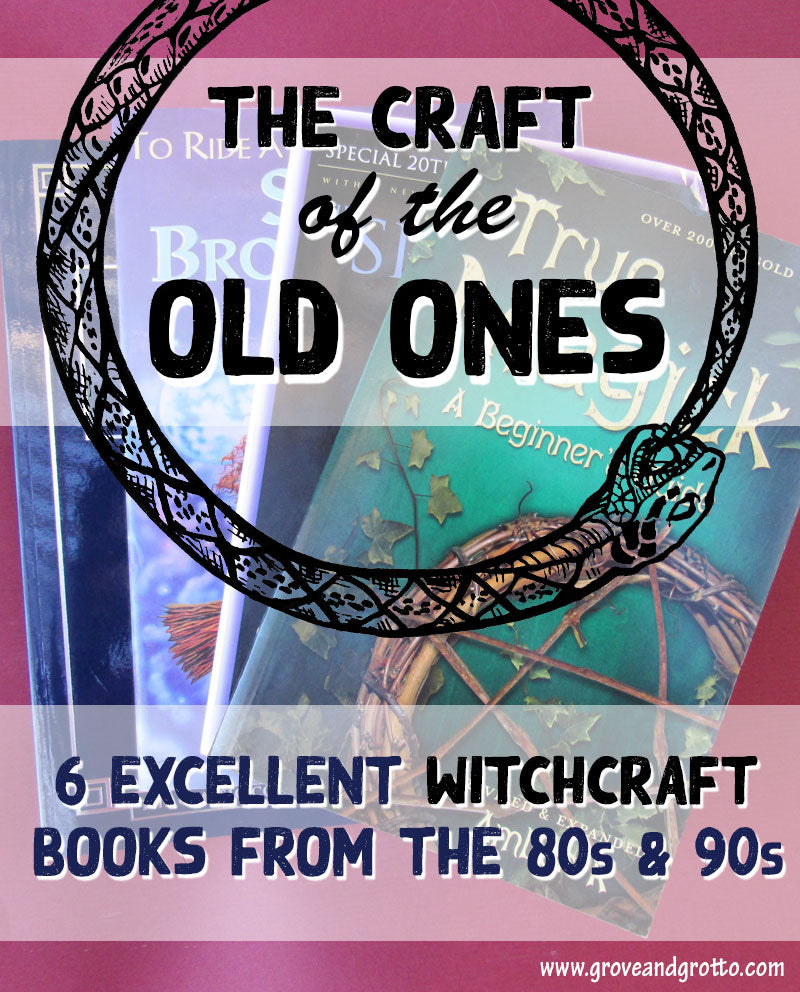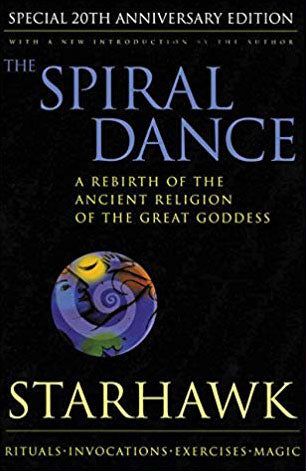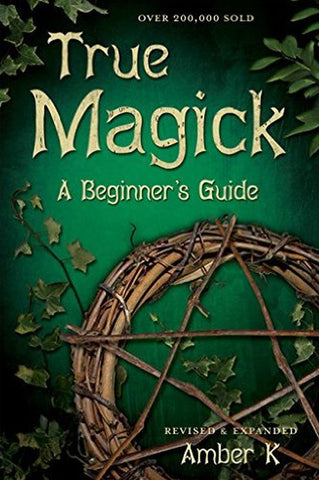
The decade is new and uncertain, the planet is melting, there are way more witchcraft books coming out every day than I can keep up with…dammit! Time to crouch down by a dusty bookshelf and get nostalgic for the books that shaped us when we were baby Witches.
Google is great for looking up a moon phase or herbal recipe—but for the dedicated Witch, there’s nothing like the printed word to guide your studies. We’ve combed through our library for classic beginner’s books that have stood the test of time.
Each one of these titles has passed the quarter-century mark and still offers something worthwhile to students of witchcraft. So pop in a cassette, order some Dominos and curl up with one of these 20th-century favorites:
Buckland’s Complete Book of Witchcraft (1986)

Buckland’s Complete Book of Witchcraft has influenced untold numbers of covens and solitary witches. With hundreds of thousands of copies in print, it casts a long blue shadow over every beginner’s book published since the 1980s. Still a student-witch standby, “Big Blue” purports to be a complete course in witchcraft, bringing the serious reader through levels of training that align with the Wiccan degree system.
Buckland was an initiate of Gerald Gardner’s coven and the first person to form a lineaged Gardnerian group in the United States. His Complete Book of Witchcraft was heavily influenced by the Gardnerian Book of Shadows (which he brought with him when he emigrated from London.)
But Buckland’s book certainly excels Gardner’s in both clarity and organization. It is plainly written for the beginner, without Gardner’s love of archaic language and obfuscation. To be fair, Buckland did not have to contend with the anti-witchcraft laws then in place in England, and seemed to enjoy his later notoriety as a public face of witchcraft. He became a prolific fiction and non-fiction writer, publishing a book almost every year until his death in 2010.
“Big Blue” is very comprehensive, and touches on just about all of the major topics a Witch may encounter in their first years of study. One of the more unusual features of the book is a list of study questions at the end of each chapter. (Useful for teachers and solitary Witches alike!) The book also includes many detailed instructions for making your own ritual tools and garments. Both features reflect Buckland’s self-reliant, pragmatic approach to witchcraft. They also hearken back to a time when magickal shops and teachers were harder to find.
Some common critiques of Buckland’s Complete Book of Witchcraft include its technophobic biases, scattershot introduction of its topics, and some passages which now read as hopelessly square or Anglo-centric. Still, there is enough excellent information in here to keep beginners busy for a while. And even experienced Witches are likely to find some new technique or method in this expansive tome.
Wicca: A Guide For the Solitary Practitioner – Scott Cunningham (1989)

Possibly the best-selling book on Wicca ever, Cunningham’s primer triggered a surge of interest in Earth-based religions. The most recent edition boasts “Over 800,000 copies sold!” Truly a staggering number for an occult title—but is its popularity justified?
Cunningham’s works had such a huge influence on later writers that it’s hard to judge Wicca: A Guide in hindsight. A lot of the material presented here seems, well, obvious now. Cunningham’s gentle, plainspoken writing was a departure from the lofty, authoritative voice of his ceremonial magician peers.
Wicca: A Guide is an invitation to embrace the spiritual essence of ourselves and our planet. It’s about honoring the seasons with simple home rituals. It introduces plant, gem, and color magick as tools for personal spellcraft. It encourages meditation and devotion as daily practices. Yes, it’s basic. That’s the point.
Cunningham’s assertion that “Magic is natural” is at the core of almost every spellbook being printed today. But at the time, it was still unusual to see witchcraft presented as not scary, not supernatural, not limited to a few initiates or specially gifted people. This book lifted the veil from ritual magick and helped a whole generation to see Wicca as a legitimate spiritual path.
It’s true that, in 2020, there’s not much that seems surprising or provocative in this book. But if you’re brand new to witchcraft—or interested in the history of modern Paganism, you could do worse than to pick up this introduction to Wicca from one of the tradition’s dear departed elders.
The Spiral Dance - Starhawk (1979)

I know, I know—it’s not technically an 80s title. But its major impact was in the 80s, and a popular revised edition came out in 1989. So, we’ll fudge a little. I’m also hesitant to call it a beginner’s book, but The Spiral Dance has introduced so many people to the Craft that it deserves a place on this list.
Written by Starhawk, a founder of the Reclaiming Collective, The Spiral Dance aspires to be nothing less than a proclamation of the religion of the future. It’s been endlessly reprinted, enshrined, argued about…and it is undoubtedly one of the short stack of books that has helped create and define modern witchcraft.
Starhawk’s book came out in 1979, a time of sweeping social change in spirituality and gender politics. At that time, there were fewer books on witchcraft, and those that were printed tended to be ambitious, groundbreaking, or both. Now, in 2020, the publishing landscape is more robust, but also more fragmented.
Writers today know that the first question out of an editor’s mouth, the first line of any set of book proposal guidelines, is likely to be, “Who is this book for?” There are books for devotees of every minor deity or tradition, books for Italian hereditary Witches who love cats, books for queer vegan Tarot readers, and so on. The major publishers cater to every niche they are aware of, and there are lots more independent publishers assembling grimoires on the most obscure corners of ritual magick and herb witchery.
In a time of infinite market segmentation, the era of far-reaching Witch manifestos may be over. I am not sure, if it was the subject of a pitch meeting today, that The Spiral Dance could answer that all-important question “Who is this book for?”
There are rituals in it, sure—but it’s not a how-to manual. Starhawk writes a lot about her experience of finding and building a spiritual community, but it’s not just a Craft memoir. Social justice, sexual (r)evolution, and ecology are at the heart of her vision of a modern Goddess religion, but it would be unfair to dismiss The Spiral Dance as a social and environmental polemic. It’s certainly not a recruitment tract (though the poetic ritual descriptions at the top of each chapter are peak magickal theater).
If you read the table of contents or the index, you can see how The Spiral Dance could function as a typical beginner’s book. But Starhawk isn’t just aiming to deliver a curriculum. She’s interested in peering into the soul of contemporary Witchcraft. The result is a grand, contemplative, progressive vision punctuated by some chants and recipes.
I revisit The Spiral Dance every few years, and I suggest that you do the same. Its complexity is occasionally frustrating, always inspiring. Who is this book for? For anyone who is interested in what magick can be, at its very best.
To Ride a Silver Broomstick - Silver RavenWolf (1993)

Just about every Witch who came of age in the 1990s remembers this book. With its garish Kool-Aid purple cover and glorious airbrushed cover Witch, it was hard to overlook. It graced the nightstands—and hid behind the Lisa Frank binders—of many a teenage girl. My own school banned it and the local library couldn't keep it from being stolen or vandalized by evangelicals. (All the fuss, of course, only served to make this "Wicca" thing seem even more alluring to middle-schoolers.)
From the very beginning, it’s been fashionable to diss Silver RavenWolf. She’s a pop writer, or an opportunist capitalizing on the occult fantasies of girls and young women. So said the haters then, so say they now. But it turns out her breakthrough book (and its follow-up titles) have aged better than anyone expected.
To Ride a Silver Broomstick is surprisingly thorough and organized. It introduces most of the major beginner’s topics: The Wiccan gods, the seasons and Sabbats, basic altar tools, psychic development, self-dedication, cleansing and consecration, candle and color magick. There are reading lists at the end of each chapter, in case you are seeking further information. Every subject—from setting up your altar to coming out as a Witch—is presented with compassion and common sense.
RavenWolf writes in a chatty, breezy style that caters directly to the aspirations and anxieties of beginner Witches. She draws heavily from the Wiccan writers that came before her, but she is the opposite of dogmatic. Instead, she encourages the reader to construct a curriculum of witchcraft that works for them. She’s never shy with her opinions and cautionary tales—but the overall tone is that magick is fun and empowering. Most importantly, the simple spells and rituals in the book work. They are consciously written for beginners and can be easily modified to fit even the most limited space and budget.
Don’t be put off by its cheesy cover. This is a solid beginner’s book. Sure, there are some odd tangents and out-there claims that may leave you scratching your head. But so what? This is the world of occult publishing. You will always have to dig through weirdness and misinformation to find the nuggets of gold—might as well let the beginners get used to it.
Anyway, if we’re going to fling poo and call Wiccan authors sellouts, we have much better targets these days. (Like those awful spellbooks at the Urban Outfitters checkout and the fake authors churning out e-books for Amazon.) Pick up a copy of this 90s gem, and leave Silver alone!
True Magick: A Beginner’s Guide – Amber K (1990)

Many of our customers know Amber K for the Pagan-themed educational posters she designed in the 80s and early 90s. (They’re still big sellers in the shop.) Her debut book, True Magick, is every bit as concise and informative. If you are looking for a practical, modern, straight-talking beginner’s book on witchcraft, I wholeheartedly recommend this one.
In its table of contents, True Magick provides a well-rounded and thoughtfully sequenced lesson plan for the aspiring Witch. A brief history of magick gives way to helpful first steps in creating a personal practice. There are chapters on magickal theory, ritual tools, spellcraft, ethics, and the variety of traditions available for study and exploration. The appendices include a glossary, a list of prompts for meditation, and enough recommended reading to keep the student busy for a very long time.
My favorite thing about Amber K’s books has always been her refreshing lack of pretension. (Her bio in the second edition reads “She was not trained in the Craft at her grandmother’s knee and does not come from a long line of hereditary Witches.”) At the same time, she takes a rigorous approach to training and ritual craft. While magick doesn’t have rules exactly, it does have some natural laws and it rewards persistent study. Too many recent books encourage beginners to “have it your way,” at the expense of real learning and growth.
Like Silver RavenWolf, Amber K has been criticized for presenting a watered-down or “fluffy” version of the Craft. But make no mistake—the rituals and practices taught in its pages are easy to learn, difficult to master. If you are very disciplined (and the universe is on your side) you can receive a decent education from books. I always recommend that solitary Witches work through a solid introductory book—like True Magick—over at least a year’s time, then revisit any topics that were particularly challenging or interesting.
Llewellyn gave True Magick a re-issue in 2006 with a new introduction and updated appendices. As of this writing, True Magick has sold over 200,000 copies and been through 15 printings. And so, this classic beginner’s guide is looking quite snazzy as it nears its 30th birthday. (Socially-minded Witches should also check out Coven Craft (2002) and RitualCraft (2006)—definitive titles on group magick and public rituals, respectively.)
The Power of the Witch – Laurie Cabot (1990)

Laurie Cabot attained celebrity status in the 1970s as “the Official Witch of Salem.” She was instantly recognizable for her big hair, dramatic cloaks and even more dramatic eye makeup. As of 2020, Cabot still lives in Salem and maintains an online store at the age of 87.
The Power of the Witch draws on Cabot’s several decades of experience as an activist, teacher/priestess, and shopkeeper. It is a calling to embrace the Witch’s path with all its beauty and challenges. To Cabot, the Witch is an outsider, a keeper of ancient rites, a warrior for wisdom and social change.
A myth is something that is more true than real. So it is with the mythology of Witchcraft that was so prevalent in the 80s and 90s. Cabot and others present Witchcraft as “the oldest western religion,” a secret tradition of wise women stretching back thousands of years. There’s an appealing fantasy of Avalon and medieval matyrdom and Stone Age goddess cults…the perfect antidote to the materialistic, patriarchal, war-torn recent decades.
Yes, the first couple of chapters of The Power of the Witch are based around spurious history and debunked Margaret Murray anthropology. Those passages indeed date the book, but they don’t lessen its appeal. The story of the Witch is just too good to be fact-checked. It’s something that’s true, regardless of the scant historical evidence for a centuries-old European witch cult.
There’s practical knowledge here, too, in addition to the myth-making. As an experienced merchant, Cabot offers good advice for finding and working with magickal tools. There are spells for attraction, prosperity, and protection. There’s also a concise, lucid summary of the Hermetic principles of magick, which Cabot taught to beginners under the name "New Science."
The Power of the Witch is a romantic and deeply sincere love letter to all humans on a magickal path. Though not as essential as some of the other books on this list, it’s still a fun read. You can even order a signed copy directly from Cabot.
Our vintage picks
Well, there you have it, my bibliophilic witches! Six oldies-but-goodies on Witchcraft published before 1995. We tried to focus this list around books that are still in print or easy to find secondhand, but there are lots of more obscure treasures out there, too.
What are your favorite 80s and 90s books or authors? Share with other readers in the comments!
Check out the archive for more articles.
